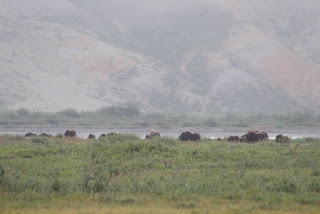 |
| Skilak Lake |
We pulled out Calypso, our blow-up boat, pumped her up, and
took a little row along the shoreline.
Rox was cold from her swim and snuggled next to me for warmth. (There’s nothing better than having a rather
damp Golden girl snuggled next to you!)
With storm clouds brewing, my captain decided he best row for shore. Roxanne, however, was content to stay in the boat.
As clouds began to darken the skies even further, David made
a campfire. We were sitting on the
concrete picnic bench, enjoying the warmth and chatting. Suddenly, things began to move. Both David and I looked at each other. It took a few seconds for us to realize that
it was an earthquake! The ground bucked
and rolled with enough strength that we grabbed one another. While it only lasted about 30 seconds, we
learned later that the quake registered 6.3, with the epicenter being under the Mt. Redoubt volcano off Cook's Inlet.
A clerk in Soldotna later told us that several items fell of her shelves
at her house. Earthquakes are not new in the area. In southeastern Alaska alone, there have been 92 earthquakes in the past week and 364 in the past month, all greater than a 1.5 rating. Wow!
Soon after the earthquake, the skies opened up and we were in a downpour that lasted most of the night. Still, the gulls on their nearby island rookery squawked their raucous lullaby throughout the night.
With misty rain greeting us the next morning, we decided to
drive to Soldotna to fill our water tank.
The visitor’s center told us that the new Fred Myers (much like a
Walmart) had water and a dump station, along with free RV parking. We waited in line for nearly a half hour to
fill our small water tank. It was amazing
how much Soldotna had grown in the past five years. The traffic was so heavy that it took several
tries to get through the main stoplights.
How different the whole area felt than it had five years ago! It was definitely no longer a sleepy little
town. We stopped by a favorite breakfast
place, ran a few quick errands, then retreated back to camp.
Soon after the earthquake, the skies opened up and we were in a downpour that lasted most of the night. Still, the gulls on their nearby island rookery squawked their raucous lullaby throughout the night.
 |
| Gull rookery on Skilak lake |
We discovered that the campground, too, was becoming full
and, unfortunately, the sites are very close together. Grey skies also continued overhead, offering
little chance for another row in Calypso.
So, we decided to break camp this morning and head to Captain Cook’s
State Park on Cook’s Inlet. We saw
several moose in the area in 2010, including a cow with twin calves. Hopefully, we will see more again this time. I must tell you… this trigger finger of mine
definitely needs a workout!


































